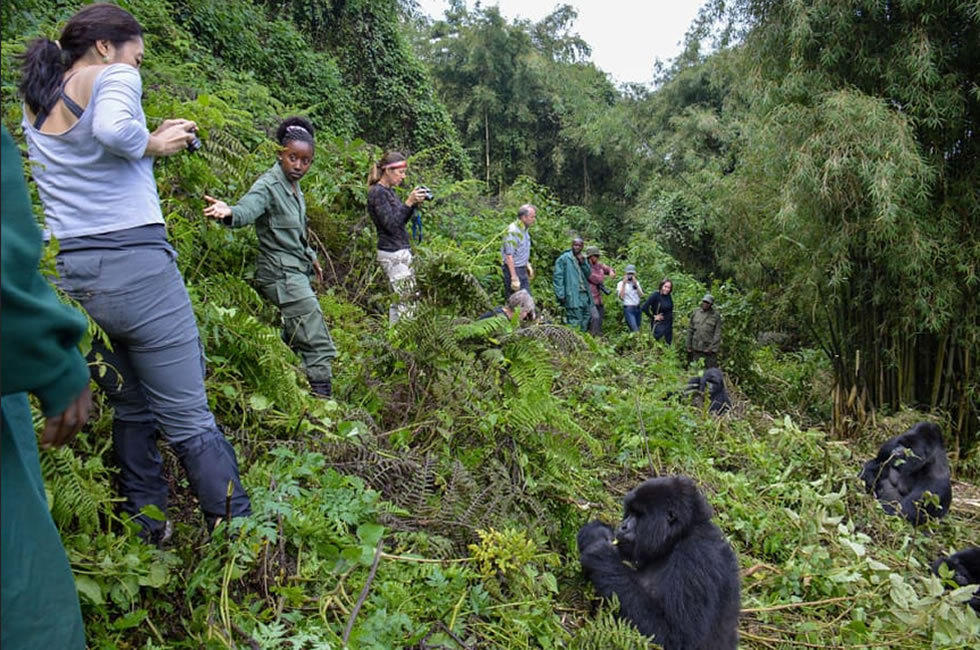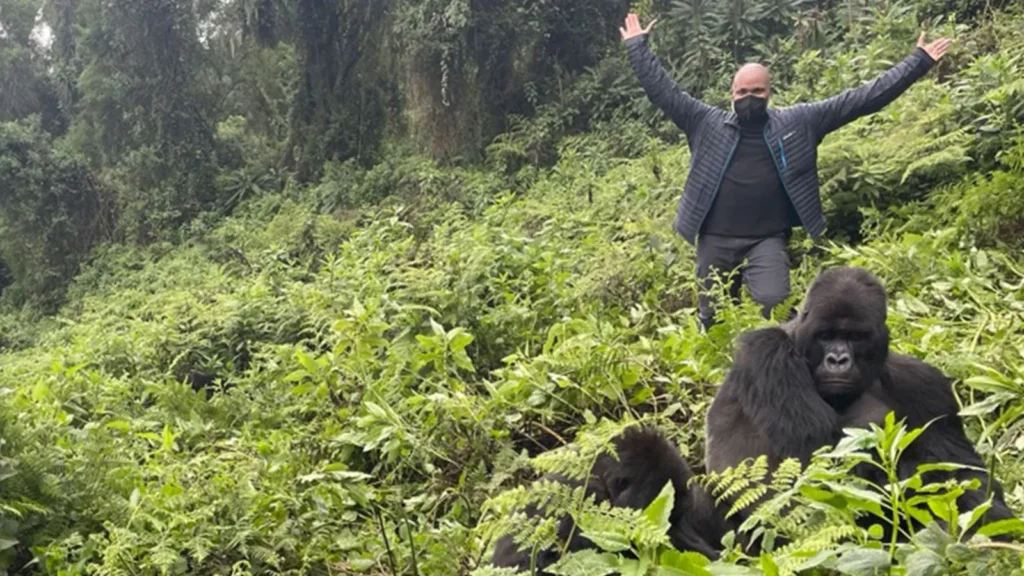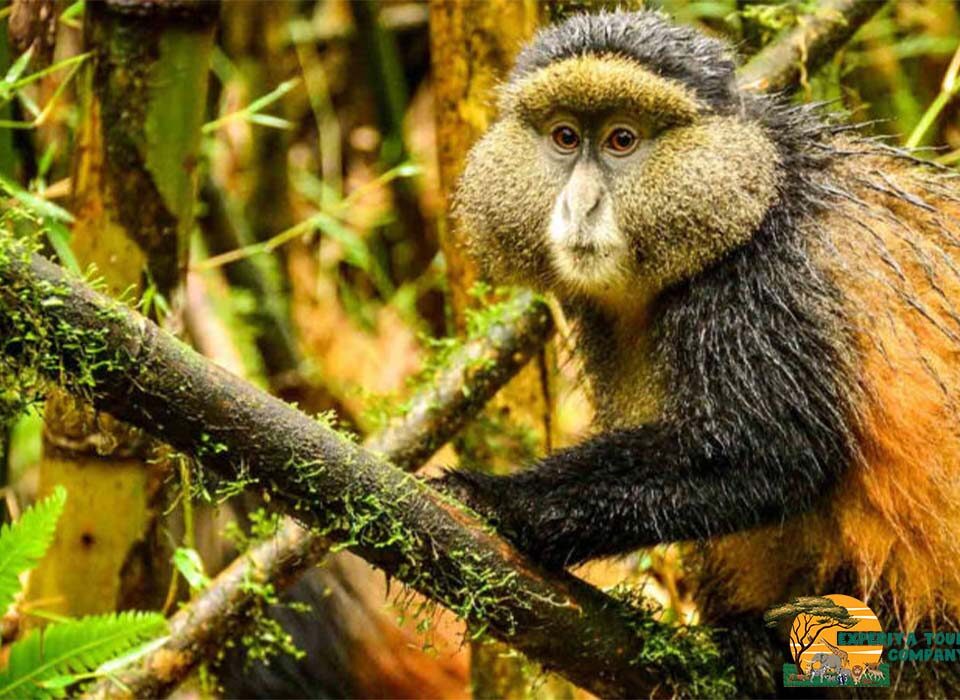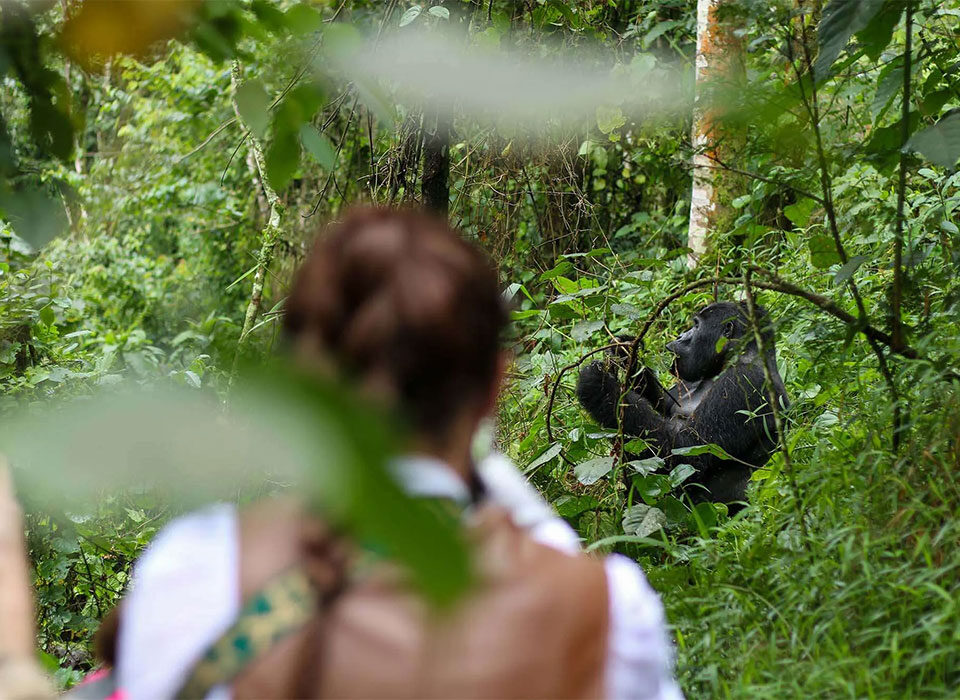
Is It Better to Trek Gorillas in Uganda or Rwanda? | Gorilla Trekking Comparison by Experiya Tour Company
October 22, 2025
Are There Age Limits for Gorilla Trekking? | Uganda & Rwanda Gorilla Trekking Rules Explained by Experiya Tour Company
October 22, 2025How Long Does a Gorilla Trek Take in Uganda? | Uganda Gorilla Trekking Duration Explained by Experiya Tour Company

How Long Does a Gorilla Trek Take in Uganda?
Gorilla trekking in Uganda is one of the most unforgettable adventures in Africa. It’s not just a wildlife experience — it’s a journey into the heart of nature, where you walk through ancient rainforests in search of the world’s last remaining mountain gorillas. But before booking your trip, one of the most common questions travelers ask is: “How long does a gorilla trek take in Uganda?”
The short answer is that gorilla treks in Uganda can take anywhere from 30 minutes to 7 hours, depending on where the gorillas are located on the day of your trek. However, the real answer is much deeper — the duration depends on several factors, such as the gorilla family you’re tracking, your fitness level, the terrain, weather conditions, and even the gorillas’ behavior. In this guide, we’ll explore everything you need to know about how long a gorilla trek takes, what to expect on the trail, and how to prepare for this once-in-a-lifetime encounter.
Where Gorilla Trekking Takes Place in Uganda
Uganda is blessed with two national parks where gorilla trekking takes place: Bwindi Impenetrable National Park and Mgahinga Gorilla National Park. Both are located in the country’s southwestern region, near the borders with Rwanda and the Democratic Republic of Congo.
Bwindi Impenetrable National Park is the main gorilla trekking destination, home to over 22 habituated gorilla families spread across four trekking sectors — Buhoma, Ruhija, Rushaga, and Nkuringo. It’s a vast, dense rainforest with steep hills, slippery slopes, and thick undergrowth. Trekking here offers a true jungle adventure and is where most travelers go.
Mgahinga Gorilla National Park is smaller and easier to navigate, located in the Virunga volcanic region. It’s home to the Nyakagezi Gorilla Family, known for its stability and playful nature. Treks here tend to be shorter and less strenuous compared to Bwindi.
Average Duration of a Gorilla Trek in Uganda
The average duration of a gorilla trek in Uganda ranges between 2 and 6 hours, including the time spent hiking to find the gorillas and returning to the starting point. However, each trek is unique, and there’s no fixed duration.
- Shortest treks: 30 minutes to 2 hours (if the gorillas are near the starting point).
- Moderate treks: 3 to 5 hours (the most common duration).
- Long treks: 6 to 7 hours or more (if the gorillas move deep into the forest).
Once you find the gorillas, you’ll spend a strictly regulated one hour observing and photographing them. This is the official time allowed by the Uganda Wildlife Authority (UWA) to minimize human impact on the gorillas.
Factors That Determine How Long a Gorilla Trek Takes
1. Gorilla Location and Movement
Gorillas are constantly on the move. They don’t stay in one place for long, as they spend their days searching for food and new resting areas. Each morning, a team of trackers sets out early to find where the gorillas nested the previous night. They follow fresh tracks, dung, and vegetation signs to determine their current position, then communicate by radio with the guides leading trekking groups.
If the gorilla family is close to the trailhead, your trek might be short and easy. But if the gorillas have moved far up the hills or deep into the forest, the trek can take several hours.

2. The Sector You’re Trekking In
Bwindi’s four sectors offer different experiences — and different levels of difficulty.
- Buhoma Sector: Located in the north, offers relatively gentle terrain and is known for shorter treks.
- Ruhija Sector: High-altitude and cooler, with moderate to long treks.
- Rushaga Sector: In the south, offers varying trek durations and the Gorilla Habituation Experience.
- Nkuringo Sector: The most challenging, with steep slopes that can make the trek longer and more demanding.
Mgahinga’s single gorilla family usually requires moderate trekking, as the park’s terrain is open with bamboo forests and fewer obstacles.
3. Terrain and Altitude
Bwindi’s elevation ranges from 1,160 to 2,607 meters above sea level, with trails that climb and descend through valleys, ridges, and streams. The terrain is rugged and often muddy, especially after rainfall. These conditions affect the trekking pace and overall duration.
Trekking in Mgahinga involves navigating volcanic slopes, but the trails are more open, and the vegetation is less dense. This often results in shorter treks.
4. Weather Conditions
Bwindi and Mgahinga are tropical rainforests, meaning rain can fall any time of year. Even during the dry seasons (June to September and December to February), the weather can change suddenly. When it rains, the trails become slippery and slower to climb, extending the trekking time.
During the wet seasons (March–May and October–November), gorillas tend to stay closer to lower altitudes because food is more abundant there. This can make treks shorter but muddier.
5. The Gorilla Family Assigned to You
Some gorilla families are known to roam further distances, while others stay near the park boundaries. When you arrive for your trek, rangers will assign you to a gorilla family based on your fitness level and preferences. Travelers who prefer shorter hikes can request a group that’s closer, while those seeking adventure can opt for a more remote family.
6. Your Fitness Level
Your physical fitness plays a major role in how long the trek feels. While the rangers set a comfortable pace for everyone, steep sections, mud, and thick vegetation can make the journey challenging. The average pace is moderate, with frequent rest stops to catch your breath, drink water, or listen to the forest sounds.
Even older or less fit travelers can complete the trek successfully, especially with the help of porters who carry backpacks and assist on steep sections.
What to Expect During the Gorilla Trek
Your trekking day starts early. After breakfast, you’ll head to the park headquarters for a pre-trek briefing at around 7:00 AM. Here, rangers will explain safety guidelines, the do’s and don’ts of gorilla trekking, and assign groups of up to eight trekkers per gorilla family.
After the briefing, you’ll meet your guides and porters and begin the trek into the forest. The first part of the walk may pass through local farmland or community land before entering the dense jungle. As you go deeper, the sounds of birds, monkeys, and rustling leaves heighten your anticipation.
Your guides will lead you at a steady pace, stopping often to check for signs of the gorillas. When the trackers confirm that the gorillas are nearby, you’ll leave your walking sticks and bags behind and approach quietly. The moment you see the gorillas — often lounging, grooming, or playing — every step of the journey feels worthwhile.
You’ll spend one precious hour observing them from a safe distance of about seven meters. During that time, you can take photos, watch family interactions, and witness the astonishing similarities between gorillas and humans. The hour flies by, and afterward, you’ll slowly hike back to the starting point, filled with awe and emotion.
The Gorilla Habituation Experience — A Longer Trek Option
If one hour feels too short, Uganda offers something truly special: the Gorilla Habituation Experience, available only in the Rushaga Sector of Bwindi. This activity allows visitors to spend up to four hours with a semi-habituated gorilla family that is still getting used to human presence.
Because the gorillas are not yet fully habituated, the trek often takes longer and feels more adventurous. You’ll accompany researchers and rangers as they follow the gorillas and record behavioral data. It’s a once-in-a-lifetime opportunity for wildlife enthusiasts who want a deeper connection and understanding of these gentle giants.
The habituation permit costs USD 1,500 per person, but the extended experience is well worth it for those who want to go beyond the standard trek.
How to Prepare for the Trek
While the trek length varies, being prepared will make it more comfortable and enjoyable. Here are some tips:
- Get fit in advance: Try walking, jogging, or hiking in the weeks leading up to your trip.
- Pack light but smart: Bring waterproof hiking boots, long pants, long-sleeved shirts, gloves, a rain jacket, insect repellent, and enough drinking water.
- Hire a porter: They’ll help carry your backpack and offer a steady hand during steep climbs.
- Listen to your guides: They know the forest well and ensure your safety at every step.
- Stay patient and flexible: Remember that gorillas move freely — the trek’s length and difficulty are part of the adventure.
Typical Day Timeline
Here’s what a typical trekking day looks like:
- 7:00 AM: Arrival at park headquarters for registration and briefing.
- 8:00 AM: Trek begins; hiking through farmland and forest.
- 10:00 AM – 1:00 PM: Depending on distance, you reach the gorilla family and spend one hour observing them.
- 1:00 PM – 4:00 PM: Return hike and drive back to your lodge.
By afternoon, you’re usually back at your accommodation, tired but fulfilled, with memories that last a lifetime.
How Difficult Is a Gorilla Trek in Uganda?
While gorilla trekking can be physically demanding, most travelers of average fitness complete it successfully. Trekkers are grouped by fitness level, and you can always request an easier or more challenging route. With good preparation, patience, and the support of guides and porters, anyone over the age of 15 can take part.
The real key to enjoying the trek is maintaining the right mindset. It’s not just about the destination — it’s about the journey. The forest’s beauty, the sounds of nature, and the anticipation of meeting gorillas make every minute of the trek worthwhile.
Why You Should Trek with Experiya Tour Company
Planning your gorilla trek in Uganda can feel overwhelming, especially when it comes to choosing sectors, securing permits, and arranging transportation. That’s where Experiya Tour Company makes the difference.
Experiya Tour Company is one of Uganda’s most experienced safari operators, specializing in gorilla trekking tours, wildlife safaris, and tailor-made itineraries across East Africa. Their professional team handles every detail — from booking your gorilla permits and recommending the right trekking sector to arranging lodges and transport from Kigali or Entebbe.
Whether you prefer a short trek in Mgahinga or a challenging adventure in Bwindi’s Nkuringo sector, Experiya’s expert guides will ensure your experience is smooth, safe, and memorable. They understand that gorilla trekking isn’t just a tour — it’s a personal journey of discovery.
With Experiya, you’ll not only see gorillas but also experience Uganda’s breathtaking landscapes, warm hospitality, and rich culture. For a well-organized, life-changing gorilla trekking adventure, travel with Experiya Tour Company — your trusted partner in exploring Uganda’s wild heart.



